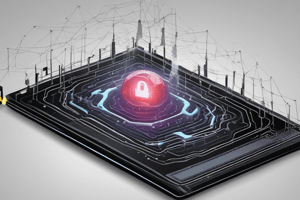Podcast
Questions and Answers
Which of the following is NOT a practice related to Authorization and Authentication?
Which of the following is NOT a practice related to Authorization and Authentication?
- Least Privilege
- Whitelisting
- Need to Know
- Firewall (correct)
What is the primary difference between Need to Know and Least Privilege principles?
What is the primary difference between Need to Know and Least Privilege principles?
- Need to Know applies to data, while Least Privilege applies to access to a system. (correct)
- Need to Know is a more restrictive principle than Least Privilege.
- Need to Know is used during the provisioning stage, while Least Privilege is implemented after the user has been provisioned.
- Need to Know is used for physical security, while Least Privilege is used for logical security.
What is the primary goal of Whitelisting?
What is the primary goal of Whitelisting?
- Identifying and removing malicious software from a system.
- Creating a list of trusted users who are allowed to access a system.
- Allowing only approved applications to run on a system. (correct)
- Blocking unauthorized users from accessing a system.
Which of the following authentication technologies is considered a form of multi-factor authentication?
Which of the following authentication technologies is considered a form of multi-factor authentication?
What is the main purpose of Context Aware Authentication?
What is the main purpose of Context Aware Authentication?
What is the main purpose of a digital signature?
What is the main purpose of a digital signature?
Which of the following is NOT a component of the NIST Cybersecurity Framework?
Which of the following is NOT a component of the NIST Cybersecurity Framework?
What is the primary purpose of the Common Vulnerabilities and Exposures (CVE) Dictionary?
What is the primary purpose of the Common Vulnerabilities and Exposures (CVE) Dictionary?
Which of the following is NOT a type of security control?
Which of the following is NOT a type of security control?
What is the main difference between Discretionary Access Control and Mandatory Access Control?
What is the main difference between Discretionary Access Control and Mandatory Access Control?
Which access control method allows administrators to set permissions based on specific criteria defined by rules?
Which access control method allows administrators to set permissions based on specific criteria defined by rules?
Which of the following is a network security tool used to identify suspicious activity and alert administrators?
Which of the following is a network security tool used to identify suspicious activity and alert administrators?
Which of the following is NOT a corrective control?
Which of the following is NOT a corrective control?
What is the concept of 'Defense in Depth' in cybersecurity?
What is the concept of 'Defense in Depth' in cybersecurity?
Which of the following is NOT a recommended practice for password management, as per NIST SP800-63B?
Which of the following is NOT a recommended practice for password management, as per NIST SP800-63B?
What is the purpose of the 'Protect' function within the NIST Cybersecurity Framework?
What is the purpose of the 'Protect' function within the NIST Cybersecurity Framework?
Which of the following is an example of a preventative control?
Which of the following is an example of a preventative control?
What is the most critical component of an incident response plan?
What is the most critical component of an incident response plan?
Which model of incident response teams is best suited for geographically widespread organizations?
Which model of incident response teams is best suited for geographically widespread organizations?
During which phase of the General Incident Response Plan does the organization ensure no further damage occurs?
During which phase of the General Incident Response Plan does the organization ensure no further damage occurs?
What type of event is defined as any intentional or unintentional event with negative consequences on systems?
What type of event is defined as any intentional or unintentional event with negative consequences on systems?
Which of the following is NOT a testing method for incident response plans?
Which of the following is NOT a testing method for incident response plans?
What does the Mean Time to Repair metric measure in incident response?
What does the Mean Time to Repair metric measure in incident response?
Which organization is known for creating various recovery frameworks besides NIST?
Which organization is known for creating various recovery frameworks besides NIST?
Which of the following losses would be covered by a cyber insurance policy?
Which of the following losses would be covered by a cyber insurance policy?
Which of the following is NOT considered a threat agent in cybersecurity?
Which of the following is NOT considered a threat agent in cybersecurity?
What is the main purpose of a Denial of Service (DoS) attack?
What is the main purpose of a Denial of Service (DoS) attack?
Which of the following attacks involves injecting malicious SQL code to manipulate a database?
Which of the following attacks involves injecting malicious SQL code to manipulate a database?
How does a Reverse Shell attack initiate communication?
How does a Reverse Shell attack initiate communication?
Which of the following is a characteristic of a brute-force attack?
Which of the following is a characteristic of a brute-force attack?
What type of malware installs a copy on a computer's memory and can remain active even after a reboot?
What type of malware installs a copy on a computer's memory and can remain active even after a reboot?
Which attack uses methods not originally intended for data transmission to communicate?
Which attack uses methods not originally intended for data transmission to communicate?
What is the main goal of a Social Engineering attack?
What is the main goal of a Social Engineering attack?
Which type of attack aims to manipulate application behavior by forcing operations to execute out of order?
Which type of attack aims to manipulate application behavior by forcing operations to execute out of order?
Which of the following is an example of spoofing in cybersecurity?
Which of the following is an example of spoofing in cybersecurity?
Which of the following correctly describes the primary goal of Data Loss Prevention (DLP)?
Which of the following correctly describes the primary goal of Data Loss Prevention (DLP)?
What is the main difference between privacy and confidentiality?
What is the main difference between privacy and confidentiality?
In which way does obfuscation protect sensitive information?
In which way does obfuscation protect sensitive information?
What type of encryption uses both a public key for encryption and a private key for decryption?
What type of encryption uses both a public key for encryption and a private key for decryption?
What is the purpose of conducting a walk-through in a security context?
What is the purpose of conducting a walk-through in a security context?
Which of the following is NOT a part of a Security Assessment Report (SAR)?
Which of the following is NOT a part of a Security Assessment Report (SAR)?
What does the 're-click rate' measure in phishing simulations?
What does the 're-click rate' measure in phishing simulations?
Which type of Data Loss Prevention (DLP) system focuses on endpoint devices?
Which type of Data Loss Prevention (DLP) system focuses on endpoint devices?
Which encryption method is often considered the highest form of data protection?
Which encryption method is often considered the highest form of data protection?
Which of the following best describes the role of a Security Program Champion?
Which of the following best describes the role of a Security Program Champion?
What is the name of the security protocol that encrypts wireless internet connections between routers, switches, and mobile devices?
What is the name of the security protocol that encrypts wireless internet connections between routers, switches, and mobile devices?
Which of the following is NOT a commonly used methodology for threat modeling?
Which of the following is NOT a commonly used methodology for threat modeling?
What is the primary goal of 'system hardening' in cybersecurity?
What is the primary goal of 'system hardening' in cybersecurity?
Which of the following cyberattacks targets specific employees within an organization?
Which of the following cyberattacks targets specific employees within an organization?
Which of the following is NOT a risk related to cloud computing?
Which of the following is NOT a risk related to cloud computing?
What is the primary purpose of a Bring Your Own Device (BYOD) policy?
What is the primary purpose of a Bring Your Own Device (BYOD) policy?
Which of the following is a type of social engineering attack that uses a phone call to deceive a victim?
Which of the following is a type of social engineering attack that uses a phone call to deceive a victim?
What is the purpose of 'Network Segmentation' in cybersecurity?
What is the purpose of 'Network Segmentation' in cybersecurity?
Which of the following is NOT a key component of the COSO Internal Control Framework?
Which of the following is NOT a key component of the COSO Internal Control Framework?
Which of the following is a common example of "Device Spoofing" in the context of IoT (Internet of Things) security?
Which of the following is a common example of "Device Spoofing" in the context of IoT (Internet of Things) security?
What is the primary purpose of "Reconnaissance" in the stages of a cyberattack?
What is the primary purpose of "Reconnaissance" in the stages of a cyberattack?
What is the main focus of the "STRIDE" threat modeling methodology?
What is the main focus of the "STRIDE" threat modeling methodology?
Which of the following is NOT a characteristic of a "Watering Hole Attack"?
Which of the following is NOT a characteristic of a "Watering Hole Attack"?
What is the main difference between "Phishing" and "Spear Phishing"?
What is the main difference between "Phishing" and "Spear Phishing"?
Which of the following is a core principle of "Database Hardening"?
Which of the following is a core principle of "Database Hardening"?
What is the primary aim of "Endpoint Hardening" in cybersecurity?
What is the primary aim of "Endpoint Hardening" in cybersecurity?
Flashcards
Hacker
Hacker
An attacker who exploits system vulnerabilities for malicious purposes.
Adversary
Adversary
A threat agent that is financially or politically motivated to gain unauthorized access to systems or data.
Denial of Service (DoS)
Denial of Service (DoS)
A type of attack that floods a network with overwhelming traffic, making it unable to respond to legitimate requests.
Man-in-the-Middle (MITM)
Man-in-the-Middle (MITM)
Signup and view all the flashcards
Return-Oriented Programming (ROP)
Return-Oriented Programming (ROP)
Signup and view all the flashcards
SQL Injection
SQL Injection
Signup and view all the flashcards
Cross-Site Scripting (XSS)
Cross-Site Scripting (XSS)
Signup and view all the flashcards
Mobile Code
Mobile Code
Signup and view all the flashcards
Overwrite Virus
Overwrite Virus
Signup and view all the flashcards
Multi-Partite Virus
Multi-Partite Virus
Signup and view all the flashcards
Worm
Worm
Signup and view all the flashcards
Trojan Horse
Trojan Horse
Signup and view all the flashcards
Adware
Adware
Signup and view all the flashcards
Spyware
Spyware
Signup and view all the flashcards
Phishing
Phishing
Signup and view all the flashcards
Spear Phishing
Spear Phishing
Signup and view all the flashcards
Business Email Compromise (BEC)
Business Email Compromise (BEC)
Signup and view all the flashcards
Pharming
Pharming
Signup and view all the flashcards
Vishing
Vishing
Signup and view all the flashcards
Network Segmentation
Network Segmentation
Signup and view all the flashcards
WiFi Protected Access (WPA)
WiFi Protected Access (WPA)
Signup and view all the flashcards
System Hardening
System Hardening
Signup and view all the flashcards
Acceptable Use Policy
Acceptable Use Policy
Signup and view all the flashcards
Bring Your Own Device (BYOD) Policy
Bring Your Own Device (BYOD) Policy
Signup and view all the flashcards
Virtual Private Network (VPN)
Virtual Private Network (VPN)
Signup and view all the flashcards
Network Hardening
Network Hardening
Signup and view all the flashcards
Server Hardening
Server Hardening
Signup and view all the flashcards
MAC Filtering
MAC Filtering
Signup and view all the flashcards
Zero Trust
Zero Trust
Signup and view all the flashcards
Least Privilege
Least Privilege
Signup and view all the flashcards
Need to Know
Need to Know
Signup and view all the flashcards
Whitelisting
Whitelisting
Signup and view all the flashcards
Context Aware Authentication
Context Aware Authentication
Signup and view all the flashcards
Digital Signatures
Digital Signatures
Signup and view all the flashcards
Single Sign-On (SSO)
Single Sign-On (SSO)
Signup and view all the flashcards
Multi-Factor Authentication
Multi-Factor Authentication
Signup and view all the flashcards
Personal Identification Number (PIN)
Personal Identification Number (PIN)
Signup and view all the flashcards
Smart Cards
Smart Cards
Signup and view all the flashcards
Token
Token
Signup and view all the flashcards
Biometrics
Biometrics
Signup and view all the flashcards
Security Assessment - Examination
Security Assessment - Examination
Signup and view all the flashcards
Security Assessment - Interviewing
Security Assessment - Interviewing
Signup and view all the flashcards
Security Assessment - Testing
Security Assessment - Testing
Signup and view all the flashcards
Security Assessment Report (SAR)
Security Assessment Report (SAR)
Signup and view all the flashcards
Determination Statement (SAR)
Determination Statement (SAR)
Signup and view all the flashcards
Incident Response Team (SAR)
Incident Response Team (SAR)
Signup and view all the flashcards
Phishing Simulation
Phishing Simulation
Signup and view all the flashcards
Security Program Champions
Security Program Champions
Signup and view all the flashcards
Tokenization
Tokenization
Signup and view all the flashcards
Encryption
Encryption
Signup and view all the flashcards
Incident Response Plan (IRP)
Incident Response Plan (IRP)
Signup and view all the flashcards
Incident Response Timeline
Incident Response Timeline
Signup and view all the flashcards
Tabletop Exercise
Tabletop Exercise
Signup and view all the flashcards
IRP Metrics
IRP Metrics
Signup and view all the flashcards
Cyber Insurance
Cyber Insurance
Signup and view all the flashcards
Containment
Containment
Signup and view all the flashcards
Eradication
Eradication
Signup and view all the flashcards
Reporting
Reporting
Signup and view all the flashcards
Study Notes
Cybersecurity Threats and Attacks
- Cybersecurity protects organizational IT infrastructure and data from malicious actors through technology, internal controls, and best practices.
- Threat agents include attackers, hackers, adversaries (with incentives to hack), government/state-sponsored actors, hacktivists (for social/political causes), insiders, and external threats.
Types of Cyberattacks
- Network-Based Attacks: Exploit network infrastructure to disrupt operations. Examples include:
- Backdoors/trapdoors
- Covert channels
- Buffer overflows
- Denial-of-service (DoS) attacks (including DDoS)
- Man-in-the-middle (MITM) attacks
- Port scanning
- Ransomware
- Reverse shell attacks
- Replay attacks
- Return-oriented programming (ROP) attacks
- Spoofing (including ARS, DNS, and hyperlink spoofing)
- Application-Based Attacks: Target applications. Examples include:
- SQL injection
- Cross-site scripting (XSS)
- Race conditions
- Mobile code attacks (overwrite, multi-partite, parasitic, polymorphic, resident viruses)
- Host-Based Attacks: Focus on individual hosts (laptops, servers, mobile devices). Examples include:
- Brute-force attacks
- Keylogger attacks
- Malware (viruses, worms, Trojans, adware, spyware)
- Rogue mobile apps
- Social Engineering Attacks: Manipulate individuals to gain access. Examples include:
- Phishing (including spear phishing, business email compromise/whaling, and pharming)
- Pretexting
- Catfishing
- Vishing
- Physical Attacks (On-Premises): Target physical hardware. Examples include:
- Intercepting discarded equipment
- Piggybacking
- Tampering (e.g., rewiring cabling, adding unauthorized devices)
- Theft
- Supply Chain Attacks: Target vulnerabilities in software or hardware supply chains. Examples include:
- Embedded malware
- Foreign-sourced attacks
- Pre-installed malware
- Vendor attacks
- Watering hole attacks
Stages of a Cyberattack
- Reconnaissance: Information gathering about target.
- Gaining Access: Entering targeted system through vulnerabilities.
- Escalation of Privileges: Increasing access levels.
- Maintaining Access: Remaining in the system.
- Network Exploitation/Exfiltration: Malicious activity, data theft.
- Covering Tracks: Removing evidence of intrusion.
Risks Related to Different Technologies
- Cloud Computing: Additional industry exposure, malware injection, compliance violations, data loss, loss of control/visibility, multi-cloud/hybrid management, IP theft.
- Mobile Technologies: Application malware, lack of updates/encryption, physical threats, unsecured Wi-Fi, location tracking.
- Internet of Things (IoT): Device mismanagement (changing defaults), device spoofing, expanded attack surface, cyberattacks, information theft, outdated firmware, malware/network attacks.
Threat Modeling Methodologies
- PASTA (Process for Attack Simulation and Threat Analysis): Structured approach to simulations.
- VAST (Visual, Agile, and Simple Threat): Scalable threat analysis.
- STRIDE (Spoofing, Tampering, Repudiation, Information Disclosure, Denial-of-Service, Elevation of Privilege): Common threat categories.
Security Mitigation Strategies
- COSO Framework: Business objectives (Operations, Record Keeping, Compliance). Five components of Internal Control (Control environment, Risk Assessment, Information & Communication, Monitoring, Control Activities).
- Security Policies: Comprehensive guidelines for security implementation. Examples include Acceptable Use Policy, Bring Your Own Device (BYOD) policy, Network Segmentation/Isolation.
- Security Technologies: VPNs, SSID use, system hardening, MAC filtering.
- Authentication/Authorization: Zero trust, least privilege, need-to-know, whitelisting. Authentication methods include context-aware, digital signatures, SSO, MFA, PIN, smart cards, tokens, biometrics.
- Password Management: Recommendations like complexity (length, character types), frequency of changes, and avoiding personal information.
- Vulnerability management: NIST Cybersecurity Framework (Identify, Protect, Detect, Respond, Recover). CVE Dictionary.
- Layered Security: Combining physical, logical, and administrative controls for defense in depth.
Security Assessment Methods
- Security Assessment Reports (SARs): Document findings, including summary, methodology, findings, recommendations, and action plans.
- Security Awareness: Training and awareness programs. Phishing simulations, champions, engagement, materials.
Confidentiality and Privacy
- Confidentiality vs. Privacy: Confidentiality protects unauthorized access/disclosure of information, privacy protects individual rights; individuals control it.
- Obfuscation, Tokenization, Masking, Encryption: Techniques for protecting sensitive data.
- Data Loss Prevention (DLP): Prevents unauthorized data transfer. Types include network-based, cloud-based, endpoint-based.
- Safeguards for data at rest: Physical, Digital, Access Controls, Change Management, Backups.
- Walk Throughs: Understanding security/privacy procedures. Types such as Read, Structured, and Fire Drills.
Incident Response
- Incident Response Plan (IRP): Procedures, people, and info for detecting, responding to, and reducing consequences of attacks.
- Incident Response Timeline: IRP showing incident occurrence, detection, containment, eradication, recovery to normal operations.
- NIST Response Team Models: Centralized, Distributed, Coordinating.
- General Incident Response Plan (PDCERRL): Preparation, Detection, Containment, Eradication, Reporting, Recovery, Learning.
- Testing IRP Plans: Simulations, metrics, post-incident reviews, periodic audits, continuous monitoring.
- Insurable Losses: Business interruption, extortion, response costs, system replacement, legal fees, reputation damage, information/identity theft.
Studying That Suits You
Use AI to generate personalized quizzes and flashcards to suit your learning preferences.




